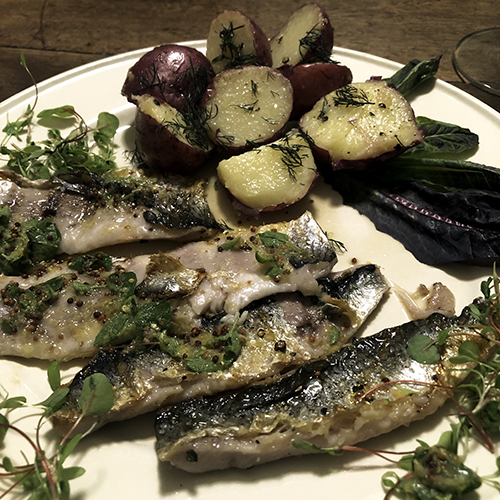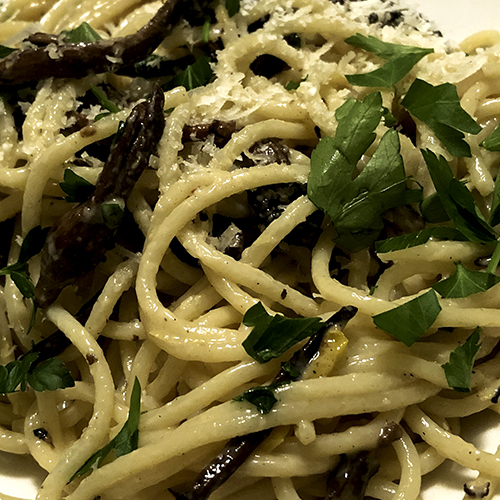
Esto no es una mole
There was no chocolate, and it’s pretty clearly a European formula.
The headline read, “Wine-Braised Goat Shanks with Tomatoes and Oregano“, so it just screamed holiday dinner.
It was December 25.
The recipe was new to me. I found it on a Seattle-based locavore food site, ‘Edible Seattle‘, where it was credited to an area goat farmer. It may not have been the fanciest pedigree, but it was absolutely delicious, made a great presentation, and it was almost entirely stressless (nearly all the work was done hours before it was served).



- two tablespoons of olive oil heated over a medium flame inside a large antique (possibly 200 years old) French newly-[re]tinned copper daubière, and two perfect 16-ounce goat shanks from LynnHaven Goat Farm in the Union Square Greenmarket, patted dry, placed inside and browned on all sides, turning several times, for about 15 minutes altogether, transferred to a plate resting on the flat unencumbered top of my 1936 Magic Chef oven that had already been heated to 325º, then a mixture of one medium red onion, 3 chopped medium orange carrots from The Grandpa farm, [there should also ,have been some chopped celery in this list, but I didn’t have any, so I substituted, for no particular reason other than that I had it, one peeled and chopped golden beet from Norwich Meadows Farm], 2 cloves of peeled rocambole garlic from Keith’s Farm, and one small chopped aji dulce yellow seasoning pepper from Eckerton Hill Farm (me tweaking the recipe) added to the pot, the vegetables seasoned with salt and pepper and cook for 10 minutes, stirring often, until soft, and a heaping tablespoon of chopped fresh oregano from Stokes Farm, 3 small fresh bay leaves from Chelsea’s West Side Market, and 8 ounces from a can of excellent Mutti peeled Italian (Parma) plum tomatoes, crushed, one and half cups of red wine (Stefano di Blasi Toscana 2018), and one cup of a very good chicken stock, made with Better Than Bullion, added, the liquid brought to a simmer, the seared goat shanks returned, a buttered piece of parchment cut to the beautiful rounded rectangle shape of the pot placed on the top of the goat and vegetables (to reduce evaporation, making for a richer daube), the pot covered and placed inside the oven to cook, turning the shanks once, for 2 to 3 hours, or until the meat was very tender, the meat then placed on a platter, or inside an au gratin and placed in the now merely warm oven (or on top of the oven, tented with aluminum foil, and the rich liquids remaining strained, discarding the solids (but retained for use in another meal, in a very substantial soup), the braising juices returned to the pot, where they were brought to a strong simmer over high heat and cooked, stirring occasionally, until reduced almost to the consistency of maple syrup, which might be about 20 minutes, the shanks then returned to the daubière, one at a time, rolled in the sauce to coat, then arranged on warm plates and served drizzled with the remaining sauce
- one cup of coarsely-ground Iroquois White Corn Project white corn flour from the Greenmarket Regional Grains Project stall in the Greenmarket) poured slowly, while whisking constantly, into 3 cups of water and one of whole milk, with one teaspoon of sea salt added, that had been heated to a simmer inside an enameled cast iron Michael Lax Copco dutch oven I’e had for half a century, the heat reduced once all had been added, and the mixture simmered, stirring, eventually using a wooden spoon, until it had thickened and the meal tasted cooked, probably 20 minutes altogether, the heat turned off and 3 tablespoons of rich butter, 1/3 cup of heavy cream, and 2 ounces of a gorgonzola dolce from Buon Italia, added and stirred until the cheese had melted, seasoned with salt and pepper to taste, served alongside the shanks [Note: polenta can be prepared ahead of time, kept warm in a double boiler over low heat for maybe 2 hours, then stirring in a little additional boiling water and stirring just before serving]
- a small bunch of sweet baby December collards tender collards from Windfall Farms, leaves and stems roughly cut, washed several times and drained, transferred to a smaller bowl very quickly in order to retain as much of the water clinging to them as possible, braised inside a heavy medium size antique tin-lined copper pot in which 2 halved cloves of garlic had first been allowed to sweat in some olive oil, finished with sea salt and freshly ground pepper, drizzled with a bit of olive oil
- the wine was a great Italian (Campania/Montevetrano) red, Colli di Salerno 2013 (cabernet sauvignon, aglianico, merlot), from Bottlerocket

There was a dessert, also stressless, since it only had to be assembled.
- water buffalo milk ice cream, with fig pieces, from the remarkable people of Riverine Ranch in the Greenmarket, each portion served with a heavily-whole wheat flour Campiello Digestive from Buon Italia
- the music throughout the meal – and beyond, was Bach’s Christmas Oratorio, with John Eliot Gardiner and the English Baroque Soloists










